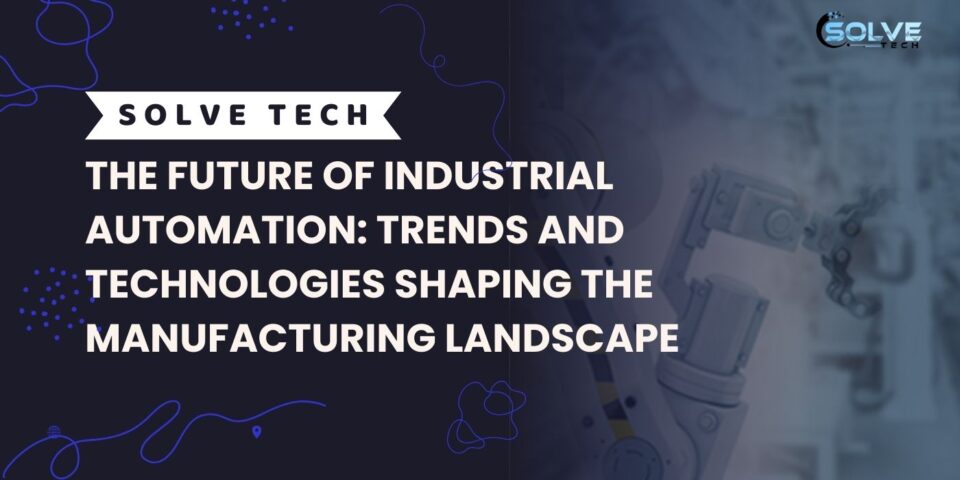- Join Dubai’s Leading Technical Training Institute Today!
- 50 6914688
- info@solvetechtraining.com
The Future of Industrial Automation: Trends and Technologies Shaping the Manufacturing Landscape

4 Expert Tips for Reducing Costs on MEP Systems in Buildings
June 17, 2024The Future of Industrial Automation: Trends and Technologies Shaping the Manufacturing Landscape
Industrial automation is rapidly transforming the manufacturing landscape, driven by advancements in technology and the increasing demand for efficiency, productivity, and flexibility. As we move further into the digital age, several trends and technologies are poised to shape the future of industrial automation, promising to revolutionize the way products are manufactured, assembled, and delivered. In this blog, we will explore the key trends and emerging technologies that are set to redefine the manufacturing sector.
1. Artificial Intelligence and Machine Learning
Artificial Intelligence (AI) and Machine Learning (ML) are at the forefront of the industrial automation revolution. These technologies enable machines to learn from data, identify patterns, and make decisions with minimal human intervention. In manufacturing, AI and ML can optimize production processes, predict maintenance needs, and enhance quality control. For instance, predictive maintenance powered by AI can significantly reduce downtime by identifying potential equipment failures before they occur, thereby improving operational efficiency.
2. Industrial Internet of Things (IIoT)
The Industrial Internet of Things (IIoT) refers to the interconnected network of industrial devices equipped with sensors, software, and connectivity. IIoT enables real-time data collection and analysis, providing valuable insights into the manufacturing process. This connectivity allows for improved monitoring, control, and optimization of industrial operations. Smart factories, leveraging IIoT, can achieve higher levels of efficiency, reduce waste, and enhance overall productivity by making data-driven decisions.
3. Robotics and Automation
Advancements in robotics are playing a crucial role in the future of industrial automation. Modern robots are more versatile, collaborative, and capable of performing complex tasks with high precision. Collaborative robots, or cobots, can work alongside human workers, enhancing productivity and safety. Automation solutions, ranging from robotic arms to autonomous guided vehicles (AGVs), are being increasingly adopted to streamline manufacturing processes, reduce labor costs, and improve product consistency.
4. Digital Twins
A digital twin is a virtual replica of a physical asset, process, or system that can be used for simulation, analysis, and optimization. In manufacturing, digital twins can model production lines, machinery, and entire factories to predict performance, identify inefficiencies, and test changes before implementing them in the real world. This technology not only enhances operational efficiency but also aids in innovation by allowing manufacturers to experiment with new designs and processes in a risk-free virtual environment.
5. Additive Manufacturing (3D Printing)
Additive manufacturing, commonly known as 3D printing, is revolutionizing the production of complex and customized parts. This technology allows for the creation of intricate designs that would be impossible or cost-prohibitive with traditional manufacturing methods. Additive manufacturing offers significant benefits, including reduced material waste, shorter lead times, and the ability to produce small batches of customized products efficiently. As 3D printing technology advances, it is expected to play a more prominent role in the manufacturing industry.
6. Augmented Reality (AR) and Virtual Reality (VR)
Augmented Reality (AR) and Virtual Reality (VR) are emerging as powerful tools in industrial automation. AR can provide real-time, context-specific information to workers, enhancing their ability to perform tasks accurately and efficiently. For example, AR can overlay assembly instructions directly onto a worker’s field of view, reducing errors and improving productivity. VR, on the other hand, is valuable for training and simulation, allowing workers to practice and perfect their skills in a virtual environment before applying them on the factory floor.
7. Edge Computing
Edge computing involves processing data closer to the source of generation, rather than relying on a centralized cloud. In industrial automation, edge computing can reduce latency, enhance data security, and enable real-time decision-making. By processing data at the edge, manufacturers can quickly respond to changes in the production environment, leading to improved efficiency and reduced downtime.
8. Blockchain Technology
Blockchain technology is gaining traction in manufacturing for its ability to provide transparency, security, and traceability. By creating an immutable record of transactions and processes, blockchain can enhance supply chain visibility, ensure product authenticity, and streamline compliance with regulatory requirements. This technology is particularly valuable in industries where traceability and transparency are critical, such as aerospace, pharmaceuticals, and food manufacturing.




